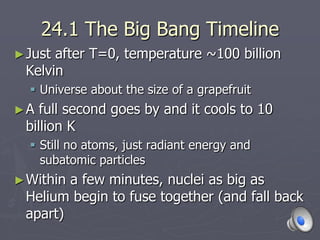HPU NCS2200 Universe Formation 1
- 1. Chapter 24 – Stars, Space, and Galaxies Earth Science and the Environment (4th ed) Thompson & Turk
- 2. 24.1 In the beginning: The Big Bang ►Theory proposed by Georges Lemaitre in 1927 based on Einstein’s theory of general relativity Derivation of the “Freidman equations” showed that the universe was expanding – not static as Einstein proposed ►In 1929 Edwin Hubble– observed that all galaxies were moving away from one another By plotting these motions, he surmised a common starting point and time
- 3. Big Bang Theory con’t ► Theory was further supported by George Gamow who introduced the Big Bang Nuecleosynthesis BBN explains the formation of the heavy isotopes of hydrogen formed in the first moments of the Big Bang ► Additional evidence was provided by Herman and Alpher who predicted the presence of Cosmic Microwave Background Radiation (CMBR) The presence of CMBR was confirmed in 1964 by Bell Laboratories employees Penzias and Wilson.
- 4. Big Bang Theory ►Additional evidence was provided by the presence of the elements Hydrogen, Helium and Lithium in abundance throughout the universe.
- 5. 24CO, p.607
- 6. 24.1 The Big Bang Timeline ►Just after T=0, temperature ~100 billion Kelvin Universe about the size of a grapefruit ►A full second goes by and it cools to 10 billion K Still no atoms, just radiant energy and subatomic particles ►Within a few minutes, nuclei as big as Helium begin to fuse together (and fall back apart)
- 7. The Big Bang Timeline ►By 10 minutes it had cooled so much that fusion couldn’t occur, still only nuclei Helium stuck around – primordial nucleosynthesis, and a trace of Lithium ►No nuclei any larger: no carbon, nitrogen, oxygen, etc. By 300,000 years, all had cooled to a few thousand degrees and electrons “stick” to nuclei Cosmic background radiation – the expected “original photons” radiate at 2.7K
- 9. 24.2 the Nonhomogenous universe ►Initial data suggested that since the CMBR was uniform throughout space that the Universe was homogenous at birth ►However, space is lumpier than one might guess Galaxies, stars, etc. are clumps of matter The “really young” universe had waves of energy that became clumps of mass during cooling
- 10. Fig. 24.3, p.611 A three-dimensional, computer-generated drawing of a portion of the Universe
- 11. Support for Big Bang Theory ►Three pieces of evidence: Red shift of galaxies Cosmic Background Radiation CMBR) Abundant elements
- 12. Red Shift ► Doppler Effect states that – waves from a moving object gather in the direction of motion, shifting the wavelength Red shift – objects moving away from the observer (position 2), the waves lengthen, move towards the red end of the spectrum Blue shift – objects moving toward the observer (Position 1) become shorter, or “bluer”
- 13. ► To understand red shift one must understand the Eletromagnetic spectrum Wavelengths of energy emitted by a body Red Shift
- 14. Red Shift: Spectra ►Visible light spectrum – an ordered array of colors exhibited by light diverging through a prism Two types of light spectra: ►Emission and absorption spectra Absorption spectrum – atoms in a stars exterior absorb certain wavelengths, creating a pattern of black absorption bands Emission spectra – when an atom absorbs radiation, it must eventually reemit it as a pattern of colored lines.
- 17. Fig. 22.33, p.578 Red Shift ► Emission spectra lines are shifted by movement of the emitting body
- 18. Support for Big Bang Theory ►Cosmic background radiation – the expected “original photons” radiate at 2.7K, In 1965, two young radio astronomers, Arno Penzias and Robert Wilson, almost accidentally discovered the CMB using a small, well- calibrated horn antenna.
- 19. Support for the Big Bang: Lighter Elements ► The wide distribution of Helium (He), Hydrogen (H) and Lithium (Li) is also evidence that supports the Big Bang theory. These elements are found in nearly every part of our universe – in stars, planets, gas clouds (nebulae) and even in space dust! Helium Hydrogen Lithium http://www.tedwolfe.com/Gallery/image_gallery.htm


















